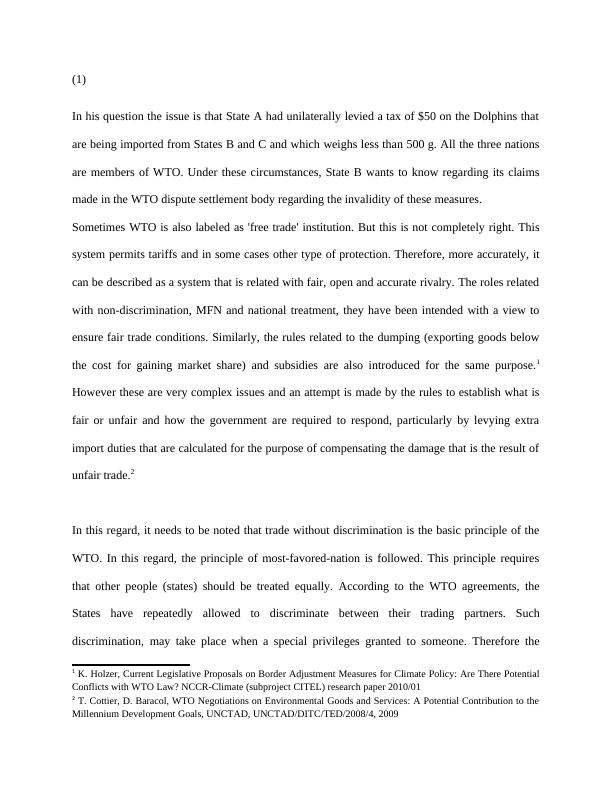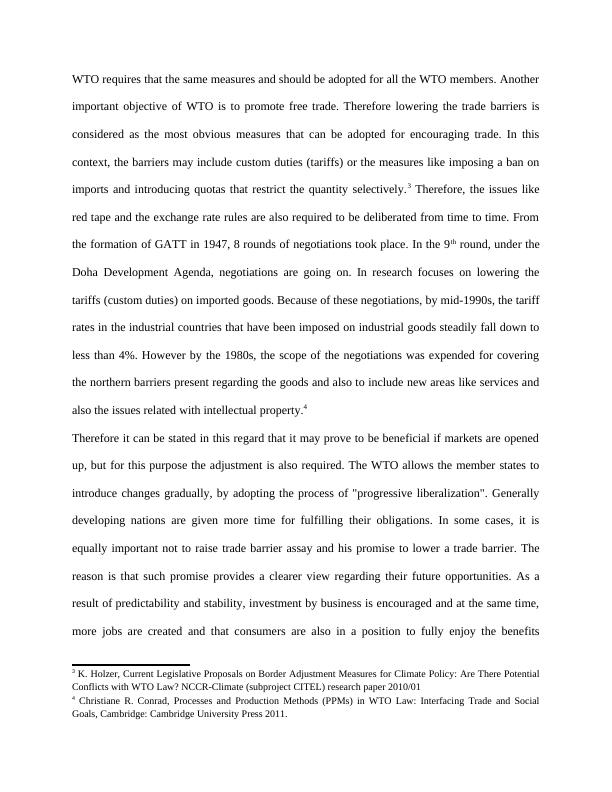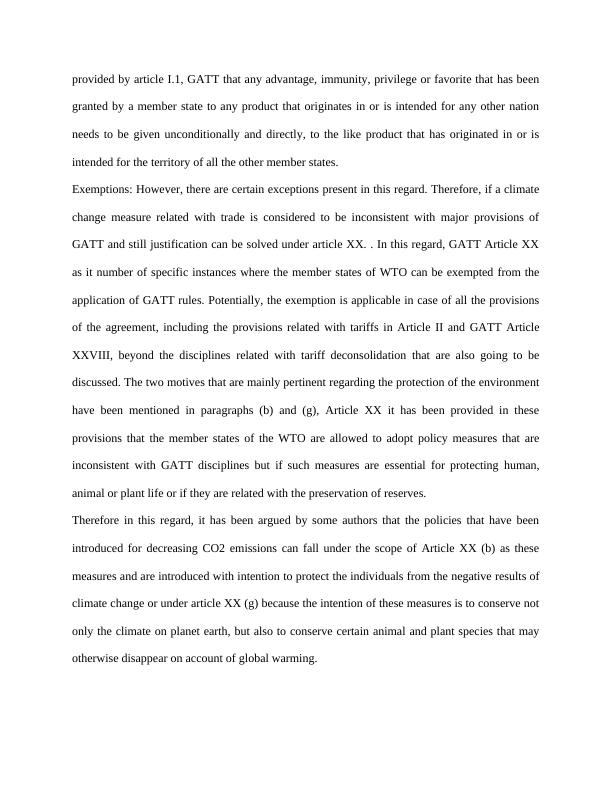WTO Dispute Settlement and Trade Regulations
Added on 2023-03-31
12 Pages3437 Words429 Views
(1)
In his question the issue is that State A had unilaterally levied a tax of $50 on the Dolphins that
are being imported from States B and C and which weighs less than 500 g. All the three nations
are members of WTO. Under these circumstances, State B wants to know regarding its claims
made in the WTO dispute settlement body regarding the invalidity of these measures.
Sometimes WTO is also labeled as 'free trade' institution. But this is not completely right. This
system permits tariffs and in some cases other type of protection. Therefore, more accurately, it
can be described as a system that is related with fair, open and accurate rivalry. The roles related
with non-discrimination, MFN and national treatment, they have been intended with a view to
ensure fair trade conditions. Similarly, the rules related to the dumping (exporting goods below
the cost for gaining market share) and subsidies are also introduced for the same purpose.1
However these are very complex issues and an attempt is made by the rules to establish what is
fair or unfair and how the government are required to respond, particularly by levying extra
import duties that are calculated for the purpose of compensating the damage that is the result of
unfair trade.2
In this regard, it needs to be noted that trade without discrimination is the basic principle of the
WTO. In this regard, the principle of most-favored-nation is followed. This principle requires
that other people (states) should be treated equally. According to the WTO agreements, the
States have repeatedly allowed to discriminate between their trading partners. Such
discrimination, may take place when a special privileges granted to someone. Therefore the
1 K. Holzer, Current Legislative Proposals on Border Adjustment Measures for Climate Policy: Are There Potential
Conflicts with WTO Law? NCCR-Climate (subproject CITEL) research paper 2010/01
2 T. Cottier, D. Baracol, WTO Negotiations on Environmental Goods and Services: A Potential Contribution to the
Millennium Development Goals, UNCTAD, UNCTAD/DITC/TED/2008/4, 2009
In his question the issue is that State A had unilaterally levied a tax of $50 on the Dolphins that
are being imported from States B and C and which weighs less than 500 g. All the three nations
are members of WTO. Under these circumstances, State B wants to know regarding its claims
made in the WTO dispute settlement body regarding the invalidity of these measures.
Sometimes WTO is also labeled as 'free trade' institution. But this is not completely right. This
system permits tariffs and in some cases other type of protection. Therefore, more accurately, it
can be described as a system that is related with fair, open and accurate rivalry. The roles related
with non-discrimination, MFN and national treatment, they have been intended with a view to
ensure fair trade conditions. Similarly, the rules related to the dumping (exporting goods below
the cost for gaining market share) and subsidies are also introduced for the same purpose.1
However these are very complex issues and an attempt is made by the rules to establish what is
fair or unfair and how the government are required to respond, particularly by levying extra
import duties that are calculated for the purpose of compensating the damage that is the result of
unfair trade.2
In this regard, it needs to be noted that trade without discrimination is the basic principle of the
WTO. In this regard, the principle of most-favored-nation is followed. This principle requires
that other people (states) should be treated equally. According to the WTO agreements, the
States have repeatedly allowed to discriminate between their trading partners. Such
discrimination, may take place when a special privileges granted to someone. Therefore the
1 K. Holzer, Current Legislative Proposals on Border Adjustment Measures for Climate Policy: Are There Potential
Conflicts with WTO Law? NCCR-Climate (subproject CITEL) research paper 2010/01
2 T. Cottier, D. Baracol, WTO Negotiations on Environmental Goods and Services: A Potential Contribution to the
Millennium Development Goals, UNCTAD, UNCTAD/DITC/TED/2008/4, 2009

WTO requires that the same measures and should be adopted for all the WTO members. Another
important objective of WTO is to promote free trade. Therefore lowering the trade barriers is
considered as the most obvious measures that can be adopted for encouraging trade. In this
context, the barriers may include custom duties (tariffs) or the measures like imposing a ban on
imports and introducing quotas that restrict the quantity selectively.3 Therefore, the issues like
red tape and the exchange rate rules are also required to be deliberated from time to time. From
the formation of GATT in 1947, 8 rounds of negotiations took place. In the 9th round, under the
Doha Development Agenda, negotiations are going on. In research focuses on lowering the
tariffs (custom duties) on imported goods. Because of these negotiations, by mid-1990s, the tariff
rates in the industrial countries that have been imposed on industrial goods steadily fall down to
less than 4%. However by the 1980s, the scope of the negotiations was expended for covering
the northern barriers present regarding the goods and also to include new areas like services and
also the issues related with intellectual property.4
Therefore it can be stated in this regard that it may prove to be beneficial if markets are opened
up, but for this purpose the adjustment is also required. The WTO allows the member states to
introduce changes gradually, by adopting the process of "progressive liberalization". Generally
developing nations are given more time for fulfilling their obligations. In some cases, it is
equally important not to raise trade barrier assay and his promise to lower a trade barrier. The
reason is that such promise provides a clearer view regarding their future opportunities. As a
result of predictability and stability, investment by business is encouraged and at the same time,
more jobs are created and that consumers are also in a position to fully enjoy the benefits
3 K. Holzer, Current Legislative Proposals on Border Adjustment Measures for Climate Policy: Are There Potential
Conflicts with WTO Law? NCCR-Climate (subproject CITEL) research paper 2010/01
4 Christiane R. Conrad, Processes and Production Methods (PPMs) in WTO Law: Interfacing Trade and Social
Goals, Cambridge: Cambridge University Press 2011.
important objective of WTO is to promote free trade. Therefore lowering the trade barriers is
considered as the most obvious measures that can be adopted for encouraging trade. In this
context, the barriers may include custom duties (tariffs) or the measures like imposing a ban on
imports and introducing quotas that restrict the quantity selectively.3 Therefore, the issues like
red tape and the exchange rate rules are also required to be deliberated from time to time. From
the formation of GATT in 1947, 8 rounds of negotiations took place. In the 9th round, under the
Doha Development Agenda, negotiations are going on. In research focuses on lowering the
tariffs (custom duties) on imported goods. Because of these negotiations, by mid-1990s, the tariff
rates in the industrial countries that have been imposed on industrial goods steadily fall down to
less than 4%. However by the 1980s, the scope of the negotiations was expended for covering
the northern barriers present regarding the goods and also to include new areas like services and
also the issues related with intellectual property.4
Therefore it can be stated in this regard that it may prove to be beneficial if markets are opened
up, but for this purpose the adjustment is also required. The WTO allows the member states to
introduce changes gradually, by adopting the process of "progressive liberalization". Generally
developing nations are given more time for fulfilling their obligations. In some cases, it is
equally important not to raise trade barrier assay and his promise to lower a trade barrier. The
reason is that such promise provides a clearer view regarding their future opportunities. As a
result of predictability and stability, investment by business is encouraged and at the same time,
more jobs are created and that consumers are also in a position to fully enjoy the benefits
3 K. Holzer, Current Legislative Proposals on Border Adjustment Measures for Climate Policy: Are There Potential
Conflicts with WTO Law? NCCR-Climate (subproject CITEL) research paper 2010/01
4 Christiane R. Conrad, Processes and Production Methods (PPMs) in WTO Law: Interfacing Trade and Social
Goals, Cambridge: Cambridge University Press 2011.

provided by competition, which are lower prices and more choice. The multilateral trading
system can be described as an attempt made by the governments for bringing stability and
predictability in the business environment.5
In the present case, decision has been made by state A to unilaterally impose a tax of $50 on the
Dolphins that have been imported from state B and C. However, state B wants to know if it can
take action under the WTO dispute settlement body's and introduce a claim of invalidity of the
measure introduced by state A. different view of the above mentioned provisions if state B
decides to take action, the likely outcome of the action is going to be successful.
(2) In this case, the issue is related with international trade regulation by the WTO and the
measures that have been introduced for climate change mitigation. The team principal in this
regard is non-discrimination. Four, national treatment principle can be described as the key
discipline of WTO and Article III, GATT which provides that a member nation is not allowed to
differentiate between its own and similar foreign products (by giving national treatment to these
products). The principle of national treatment becomes particularly relevant when regulation
related with climate change is going to be applied differently in case of domestic and foreign
producers. It has been provided by the most-favored-nation clause that a member state of the
WTO is not allowed to discriminate between the like products coming from various trading
partners (and providing the status of 'most-favored-nation' equally). In the same way it has been
5 T. Cottier, M. Oesch, International Trade Regulation. Law And Policy In The WTO, The European Union And
Switzerland, Cases Materials And Comments, Cameron May Ltd. London, 2005, p. 606
system can be described as an attempt made by the governments for bringing stability and
predictability in the business environment.5
In the present case, decision has been made by state A to unilaterally impose a tax of $50 on the
Dolphins that have been imported from state B and C. However, state B wants to know if it can
take action under the WTO dispute settlement body's and introduce a claim of invalidity of the
measure introduced by state A. different view of the above mentioned provisions if state B
decides to take action, the likely outcome of the action is going to be successful.
(2) In this case, the issue is related with international trade regulation by the WTO and the
measures that have been introduced for climate change mitigation. The team principal in this
regard is non-discrimination. Four, national treatment principle can be described as the key
discipline of WTO and Article III, GATT which provides that a member nation is not allowed to
differentiate between its own and similar foreign products (by giving national treatment to these
products). The principle of national treatment becomes particularly relevant when regulation
related with climate change is going to be applied differently in case of domestic and foreign
producers. It has been provided by the most-favored-nation clause that a member state of the
WTO is not allowed to discriminate between the like products coming from various trading
partners (and providing the status of 'most-favored-nation' equally). In the same way it has been
5 T. Cottier, M. Oesch, International Trade Regulation. Law And Policy In The WTO, The European Union And
Switzerland, Cases Materials And Comments, Cameron May Ltd. London, 2005, p. 606

provided by article I.1, GATT that any advantage, immunity, privilege or favorite that has been
granted by a member state to any product that originates in or is intended for any other nation
needs to be given unconditionally and directly, to the like product that has originated in or is
intended for the territory of all the other member states.
Exemptions: However, there are certain exceptions present in this regard. Therefore, if a climate
change measure related with trade is considered to be inconsistent with major provisions of
GATT and still justification can be solved under article XX. . In this regard, GATT Article XX
as it number of specific instances where the member states of WTO can be exempted from the
application of GATT rules. Potentially, the exemption is applicable in case of all the provisions
of the agreement, including the provisions related with tariffs in Article II and GATT Article
XXVIII, beyond the disciplines related with tariff deconsolidation that are also going to be
discussed. The two motives that are mainly pertinent regarding the protection of the environment
have been mentioned in paragraphs (b) and (g), Article XX it has been provided in these
provisions that the member states of the WTO are allowed to adopt policy measures that are
inconsistent with GATT disciplines but if such measures are essential for protecting human,
animal or plant life or if they are related with the preservation of reserves.
Therefore in this regard, it has been argued by some authors that the policies that have been
introduced for decreasing CO2 emissions can fall under the scope of Article XX (b) as these
measures and are introduced with intention to protect the individuals from the negative results of
climate change or under article XX (g) because the intention of these measures is to conserve not
only the climate on planet earth, but also to conserve certain animal and plant species that may
otherwise disappear on account of global warming.
granted by a member state to any product that originates in or is intended for any other nation
needs to be given unconditionally and directly, to the like product that has originated in or is
intended for the territory of all the other member states.
Exemptions: However, there are certain exceptions present in this regard. Therefore, if a climate
change measure related with trade is considered to be inconsistent with major provisions of
GATT and still justification can be solved under article XX. . In this regard, GATT Article XX
as it number of specific instances where the member states of WTO can be exempted from the
application of GATT rules. Potentially, the exemption is applicable in case of all the provisions
of the agreement, including the provisions related with tariffs in Article II and GATT Article
XXVIII, beyond the disciplines related with tariff deconsolidation that are also going to be
discussed. The two motives that are mainly pertinent regarding the protection of the environment
have been mentioned in paragraphs (b) and (g), Article XX it has been provided in these
provisions that the member states of the WTO are allowed to adopt policy measures that are
inconsistent with GATT disciplines but if such measures are essential for protecting human,
animal or plant life or if they are related with the preservation of reserves.
Therefore in this regard, it has been argued by some authors that the policies that have been
introduced for decreasing CO2 emissions can fall under the scope of Article XX (b) as these
measures and are introduced with intention to protect the individuals from the negative results of
climate change or under article XX (g) because the intention of these measures is to conserve not
only the climate on planet earth, but also to conserve certain animal and plant species that may
otherwise disappear on account of global warming.

End of preview
Want to access all the pages? Upload your documents or become a member.
Related Documents
WTO Dispute Settlement: State B's Claims on Invalidity of Tax Measureslg...
|12
|3174
|104
Specific Rules And Regulations For Tradinglg...
|6
|1317
|16
The Conflict and Negotiationlg...
|5
|1394
|15
Tariff, Quotas, Non-Tariff Barrier in International Marketinglg...
|6
|1092
|61
Assignment On Trade Environmentlg...
|15
|4173
|19
Doha Round of WTO Agreementslg...
|7
|2042
|62